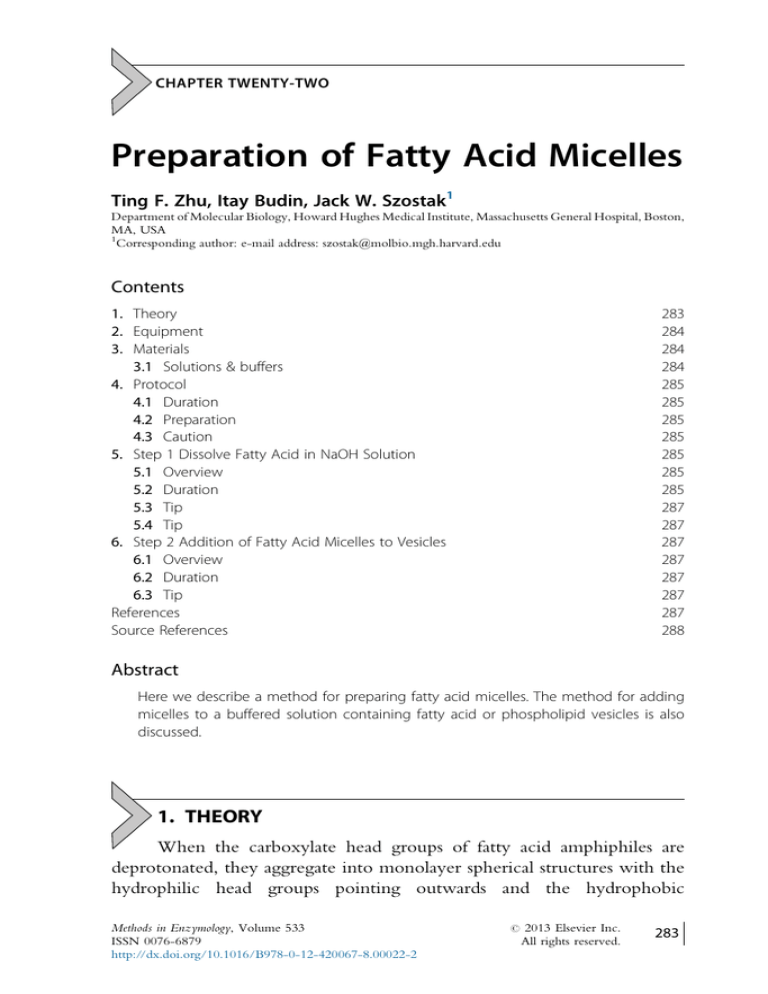
CHAPTER TWENTY-TWO
Preparation of Fatty Acid Micelles
Ting F. Zhu, Itay Budin, Jack W. Szostak1
Department of Molecular Biology, Howard Hughes Medical Institute, Massachusetts General Hospital, Boston,
MA, USA
1
Corresponding author: e-mail address: szostak@molbio.mgh.harvard.edu
Contents
1. Theory
2. Equipment
3. Materials
3.1 Solutions & buffers
4. Protocol
4.1 Duration
4.2 Preparation
4.3 Caution
5. Step 1 Dissolve Fatty Acid in NaOH Solution
5.1 Overview
5.2 Duration
5.3 Tip
5.4 Tip
6. Step 2 Addition of Fatty Acid Micelles to Vesicles
6.1 Overview
6.2 Duration
6.3 Tip
References
Source References
283
284
284
284
285
285
285
285
285
285
285
287
287
287
287
287
287
287
288
Abstract
Here we describe a method for preparing fatty acid micelles. The method for adding
micelles to a buffered solution containing fatty acid or phospholipid vesicles is also
discussed.
1. THEORY
When the carboxylate head groups of fatty acid amphiphiles are
deprotonated, they aggregate into monolayer spherical structures with the
hydrophilic head groups pointing outwards and the hydrophobic
Methods in Enzymology, Volume 533
ISSN 0076-6879
http://dx.doi.org/10.1016/B978-0-12-420067-8.00022-2
#
2013 Elsevier Inc.
All rights reserved.
283
284
Ting F. Zhu et al.
hydrocarbon chains pointing inwards. These fatty acid micelles, when added
to fatty acid or phospholipid vesicles, can be incorporated into the vesicle
membranes, leading to an increase of vesicle surface area (Berclaz et al.,
2001; Hanczyc et al., 2003; Zhu and Szostak, 2009).
2. EQUIPMENT
Vortex mixer
pH meter
Single depression glass slides
1.5-ml microcentrifuge tubes
3. MATERIALS
Oleic acid
Myristoleic acid
Sodium hydroxide (NaOH)
Deionized water
3.1. Solutions & buffers
Step 1 NaOH solution
Component
Final concentration
Stock
Amount
NaOH
100 mM
10 M
1 ml
Add water to 100 ml
Oleic acid/NaOH solution
Component
Final Concentration
Stock
Amount
Oleic acid
100 mM
>99%
32 ml
NaOH
100 mM
100 mM
1 ml
Myristoleic acid/NaOH solution
Component
Final concentration
Stock
Amount
Myristoleic acid
100 mM
>99%
28 ml
NaOH
100 mM
100 mM
1 ml
285
Preparation of Fatty Acid Micelles
Figure 22.1 Flowchart of the complete protocol, including preparation.
4. PROTOCOL
4.1. Duration
Preparation
About 10 min
Protocol
About 1 h
4.2. Preparation
Fatty acids are often shipped in sealed glass ampules. Break the ampule and pipette the
fatty acid into a 1.5-ml microcentrifuge tube for later use.
4.3. Caution
Use paper towels or clean gloves to wrap the ampule to avoid injuries from broken
pieces of glass. All lipids should be stored at 20 C.
See Fig. 22.1 for the flowchart of the complete protocol.
5. STEP 1 DISSOLVE FATTY ACID IN NAOH SOLUTION
5.1. Overview
Dissolve the fatty acid in a NaOH solution at a 1:1 molar ratio.
5.2. Duration
20 min
1.1 Pipette an appropriate amount (see the Solutions & buffers section) of
fatty acid into the bottom of a 1.5-ml microcentrifuge tube. Add the
286
Ting F. Zhu et al.
NaOH solution, so that the final molar amounts of the fatty acid and
NaOH in the solution are equal.
1.2 Vortex the sample using a vortex mixer for 30 s to fully disperse the
fatty acid in the NaOH solution (see Fig. 22.2). (Large visible air bubbles may form during the process, as shown in Figs. 22.2 & 22.3.)
1.3 Allow the sample to sit for 1 h until the air bubbles disappear. Fatty acid
micelles should form during this incubation.
Figure 22.2 Vortex the sample using a vortex mixer for 30 s to fully disperse the fatty
acid in the NaOH solution.
Figure 22.3 Large visible air bubbles appear after vortexing.
Preparation of Fatty Acid Micelles
287
5.3. Tip
The sample should be maintained above the melting temperature of the fatty acid(s)
used.
5.4. Tip
Avoid exposure to light by wrapping aluminum foil around the sample. Avoid exposure to oxygen by flushing the container with argon or nitrogen gas.
6. STEP 2 ADDITION OF FATTY ACID MICELLES
TO VESICLES
6.1. Overview
Add fatty acid micelles to fatty acid vesicles or phospholipid vesicles for
experiments on vesicle growth.
6.2. Duration
10 min
2.1 To ensure rapid mixing of fatty acid micelles and vesicles, first pipette
an appropriate amount of micelles into a 1.5-ml microcentrifuge tube
and then add a volume of the vesicle suspension. Stir the solution with
the pipette tip for rapid mixing.
2.2 For imaging, it is necessary to keep the vesicles in the field of view upon
the addition of fatty acid micelles. A single depression glass slide can be
used: pipette a drop of micelles onto the middle of the single depression
glass slide, add vesicles onto the slide, and briefly stir the sample with the
pipette tip.
6.3. Tip
The vesicle suspension should be buffered to avoid pH changes upon the addition of
fatty acid micelles that contain NaOH.
REFERENCES
Referenced Literature
Berclaz, N., Muller, M., Walde, P., & Luisi, P. L. (2001). Growth and transformation of vesicles studied by ferritin labeling and cryotransmission electron microscopy. The Journal of
Physical Chemistry B, 105, 1056–1064.
Hanczyc, M. M., Fujikawa, S. M., & Szostak, J. W. (2003). Experimental models of primitive
cellular compartments: Encapsulation, growth, and division. Science, 302(5645),
618–622.
288
Ting F. Zhu et al.
Zhu, T. F., & Szostak, J. W. (2009). Coupled growth and division of model protocell
membranes. Journal of the American Chemical Society, 131(15), 5705–5713.
SOURCE REFERENCES
Chen, I. A., Roberts, R. W., & Szostak, J. W. (2004). The emergence of competition
between model protocells. Science, 305(5689), 1474–1476.





